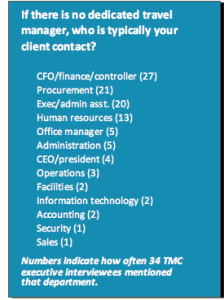The American Society of Travel Agents (ASTA) is proud to have partnered with The Company Dime to produce “Unmanaged to Managed: Why and How Companies Formalize Travel Programs,” a groundbreaking research project focused on the barriers and opportunities related to converting “unmanaged” business travel to managed travel.
With an eye toward tackling critical challenges in the corporate space and further strengthening ASTA’s role as a thought leader in the industry, the report draws on the expertise of The Company Dime, ASTA and its corporate members to illuminate issues such as how to define managed versus unmanaged travel; what spurs companies to look into engaging with Travel Management Companies (TMCs); how TMCs can “create the customer;” and other business insights for travel agencies.
A Diverse Market
 New tech tools are bringing business travel management to a wider audience. This blurs the line between the traditional concepts of “unmanaged” and “managed” travel. In late 2016, the American Society of Travel Agents and The Company Dime set out to better understand the difference. We decided to explore the barriers and opportunities related to converting unmanaged business travel to managed travel. Why do companies large and small implement travel management practices? Why don’t they? What role do travel agencies play, and what other services are crucial to the shift? In short, we wanted to find out how travel management companies create customers in today’s market.
New tech tools are bringing business travel management to a wider audience. This blurs the line between the traditional concepts of “unmanaged” and “managed” travel. In late 2016, the American Society of Travel Agents and The Company Dime set out to better understand the difference. We decided to explore the barriers and opportunities related to converting unmanaged business travel to managed travel. Why do companies large and small implement travel management practices? Why don’t they? What role do travel agencies play, and what other services are crucial to the shift? In short, we wanted to find out how travel management companies create customers in today’s market.
One of the key observations from TMC executives and officials was that no two clients are alike. Also noteworthy and variable is who within the client company is responsible for travel. Identifying this person is not always easy, and he or she may wear many hats. The function’s traditional homes within human resources, office management or executive administration still exist. But now finance or procurement departments often take the lead. For smaller companies, it could be the CFO, CPO or even CEO. The decision maker isn’t always the person overseeing travel day in and day out. In fact, he or she may hardly travel for business.
Once the decision is made to begin using a travel management company, companies often are not starting from scratch. Many have a travel policy in place, according to survey respondents. Whether those are followed is another question. Many also have a corporate card program, which serves as a foundation.
Accepting, then, that one size does not fit all, what general conclusions can we draw about this highly coveted client?
Additional sections in the upcoming full report:
What is Managed Travel?
We asked dozens of travel management company executive to define managed travel. We synthesize their answers, dig into the core components and explain why many companies don’t bother.
Why Companies Decide to Manage Travel?
There are many reasons why a managed travel program is helpful, if not essential. We break down the various motivations.
Create the Customer
Businesses often don’t know what they don’t know. That’s where travel management companies come in. Survey respondents tell us how they find customers, bust myths and explain their merits.
Startups and the Expansion of Managed Travel
Are consumer-style startups creating managed-travel customers or competing for yours? We highlight players in the new crop.
Take a look at what we have to offer, which ranges from labor issues to GDS usage to financial benchmarking, at ASTA.org/Publications. And don’t forget that ASTA membership includes preferential pricing for these reports, and in some cases complimentary access. Support your national trade association and join ASTA today!



